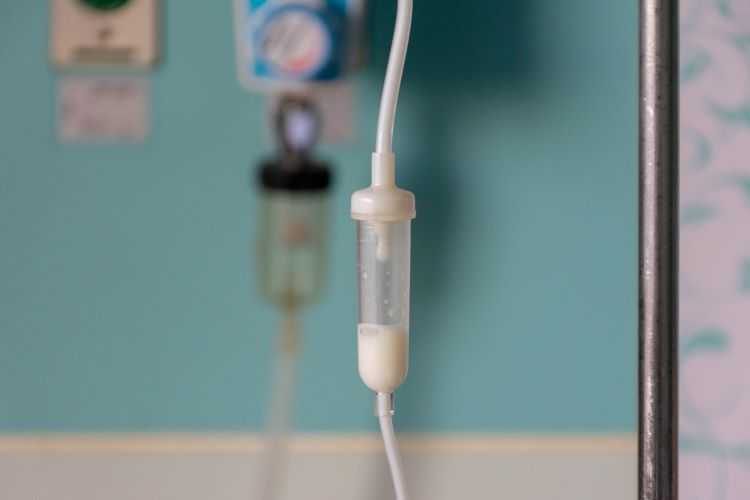- Enteral nutrition is used when a person has trouble meeting their nutrition needs orally.
- Enteral nutrition comes in the form of liquid formulas given through a feeding tube.
- Tube feeding delivers nutrition directly into the stomach or small intestine.
- Common reasons for tube feeding include swallowing problems, critical illness, and treatments affecting the ability to eat like radiotherapy to the head and neck area.
3 minute read
Enteral nutrition or tube feeding is a method of supplying nutrition through a feeding tube. This tube goes directly into the stomach or small intestine, bypassing the mouth and oesophagus.
It is an option when adequate nutrition cannot be taken by mouth. But otherwise, a person’s gut is still working normally to digest and absorb food.
Enteral nutrition may make up a person’s entire nutrition needs or can supplement what they eat and drink by mouth.
Enteral nutrition formulas are a liquid food that are high in energy, protein and other nutrients that complement a person’s normal diet. There are commercial enteral formulas available and they can also be homemade.
Interest in blenderised tube feeding (BTF) is growing. BTF is feeding by the use of blended foods and liquids given directly into the feeding tube. The food could be homemade, commercial formula mixed with pureed baby food or any of the variety of commercially available ready-to-use BTFs. There are potential drawbacks to the use of BTF including the increased risk of bacterial contamination, greater risk of clogged feeding tubes and more effort involved in the preparation of the feed. This is where dietitians can help advise on the most appropriate type of food or formula for a person and tailor the advice to the needs of the individual.
If a person can't absorb nutrients because of problems such blockage or disease in parts of the gastrointestinal tract, then nutrition needs to be given directly into the bloodstream. This type of feeding is called parenteral nutrition.

Reasons for enteral nutrition
A person needing tube feeding usually has a condition or injury that prevents them from eating an adequate regular diet by mouth. Common reasons for using this type of nutrition include:
- stroke or other neurological conditions which impairs swallowing
- after some types of operations to the head, neck or stomach
- after radiotherapy to the head and neck area
- being unable to consume adequate nutrients
- severe illness or injury which reduces the ability to eat
- poor growth (failure to thrive) or inability to eat in young children or infants.
Types of feeding tubes
There are two different groups of feeding tubes.
Nasogastric and nasojejunal feeding tubes
The first type makes use of the nose to pass a feeding tube into the stomach (nasogastric tube) or small intestine (nasojejunal tube). Specialised liquid nutrition formulas or blenderised tube feeds can then be given through the tube. This type of feeding is generally used for short-term situations where the person is likely to return to oral eating within weeks.
Gastrostomy and jejunostomy feeding tubes
The second type delivers nutrition through the abdominal wall into the stomach (gastrostomy tube) or small intestine (jejunostomy tube). This type of feeding is used when it is likely that a person’s ability to eat will not recover quickly or may not recover at all.
Feeding tubes are usually inserted during a person’s hospital stay. But feeding through the tube may continue after a person returns home or to a nursing facility. If tube feeding support is provided at home, this is known as home enteral nutrition (HEN).
Dietitians are normally involved in all stages of the enteral nutrition process. A dietitian will assess a person to see if enteral nutrition is suitable for them. Dietitians are also involved in the monitoring of the feeding and supporting the person if they return home and still need tube feeding.
Risks to do with tube feeding
Even when it is medical appropriate to use, enteral nutrition is not without its risks. People with a feeding tube are at risk of complications such as aspiration where the feed goes into the airways.
There can also be the risk of infection of the feeding tube at the place it is inserted. The physical presence of a feeding tube can also be a source of irritation or pain. Diarrhoea, constipation, nausea and bloating are also common problems that a person may experience.

Enteral nutrition needs the help and support of a professional. An Accredited Practising Dietitian (APD) can help you meet your individual needs.
We recommend seeing a dietitian if you:
- would like advice on whether you need tube feeding
- need advice to help ensure you're meeting your individual nutrient needs
- are experiencing problems with your current enteral nutrition regimen
- would like personalised advice and support from a professional.
APDs are university-trained nutrition experts. They can help you with personalised, easy-to-follow and evidence-based advice.
APDs are Australia's most trusted dietetics professionals.
- Seek support and advice from an Accredited Practising Dietitian (APD) who is experienced in tube feeding if you think you or a family member may need enteral nutrition.